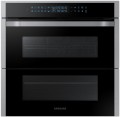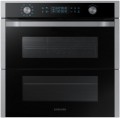Controls
The type of control panel installed in the oven. To date, there are such options:
—
Rotary knobsswitches. Controls based on classic rotary knobs, known to many users for other types of kitchen appliances — primarily classic cookers. This type of control can be found in both low-cost and advanced models: the specifics of the operation of ovens are such that many functions (both basic and additional) are conveniently controlled with rotary knobs and the simplest mechanical controls, and a complex electronic circuits. However, rotary knobs in their pure form are not used very often today — much more often they are combined with buttons or touch controls (see below).
—
Push-buttons. Push-button controls are typical of the electronic type and use complex control circuits, making this type of control suitable for models with a wide range of additional features. However, pure push-button controls, without rotary knobs, are very rare in ovens. On the one hand, for some functions, such controls are less convenient than rotary knobs; on the other hand, they are rather unusual for ovens, which can cause additional discomfort for the user.
—
Touch controls. They are in many ways similar to push-buttons (see above). The main difference between touch controls and buttons is that the touch controls respond to touch, not to press. Thanks to this, using such pane
...ls is much easier. In addition, the touch sensors give the device a stylish look and are easy to clean because they do not have protruding parts. Such controls in their pure form, not combined with rotary knobs, are also quite rare. However, for several reasons, there are still much more touch controls models than push-button ones.
— Rotary knobs with push-buttons. Control panels equipped with both rotary knobs and buttons. See above for more details on both. Here we note that the combination of two types of control allows not only to combine their advantages but also provides additional convenience: some functions of the oven can be tied to rotary knobs, others to buttons, linking each function with the type of control that is optimal for it. Due to this, this option is the most common today.
— Rotary knobs with touch controls. Combined control with rotary knobs and touch controls (see above for more on both). Like the “rotary knobs with push-buttons” option (also described above), it is very convenient because each function of the oven is tied to the type of control that is optimal for it — either to the rotary knob or to the touch controls. This option is much less common, but this is not due to inconvenience but primarily to the high cost of touch controls compared to push-buttons. Accordingly, it is used mainly in models of the middle and top classes.
— Pop out knobs. A variation of the rotary knobs described above, in which the knobs can be recessed into the control panel. Usually, pop out knobs are designed to stay outside only during the direct setting of the operating mode, and for the time when the oven is not in use or works in one mode, they can be hidden. It gives the unit a neat appearance, reduces the places where dirt can accumulate and makes the front panel easier to clean. Unlike rotary knobs, pop out knobs are mainly used in electrical models.
— Pop out knobs with push-buttons. Controls combining Pop out knobs with push-buttons. Both of these types of controls are described above, and in itself, this option is almost the same as a combination of buttons with rotary knobs (also see above).
— Pop out knobs with touch controls. A variant, by the name, combines pop out knobs and touch controls. Each of these types of control is described separately above, and their combination is almost no different from the combination of rotary knobs with touch controls (also see above). Except with the correction that recessed knobs keep the number of protruding elements on the control panel to an absolute minimum.Features
Among the ovens features, one can single out the basic ones inherent in most devices (
gas control,
auto ignition,
thermostat, timer,
auto switch-off,
child lock), and top-level features that are relevant for devices of the highest category (
control via Internet,
built-in video camera,
TFT display). More about them:
— Gas control. Thermoelectric system designed to protect against gas leakage. If the flame is accidentally extinguished, the gas supply to the chamber is immediately stopped. The gas control usually includes a thermocouple (to determine the presence or absence of a flame) and a gas blocking device.
— Auto ignition. A system that provides automatic ignition of gas simultaneously with the start of its supply. The user does not need to use matches or a lighter, press a separate button, etc.: the gas ignites immediately when the handle is turned. Found only in models with appropriate heaters (see "Oven").
— Thermostat. A device that maintains a predetermined temperature in the oven.
— Timer. A device that provides a countdown time and allows you to control the cooking process precisely. After the set time has elapsed, the timer, usually, beeps, and in some models, i
...t also turns off the heating. Timers can be either mechanical or electronic; the first one is simple and inexpensive, and the second one is more accurate and better combined with additional features (for example, auto switch-off).
— Auto switch-off. In this case, we are talking about a function that provides automatic shutdown of the oven according to the timer (see below); the timer itself does not imply auto-off, so if such an ability is important, you should choose a model where it is directly stated. Also, auto switch-off can be provided as a protective system that prevents overheating — such automation turns off the oven if no commands have been received from the user for a long time or when the temperature rises critically.
— Control via Internet. The specific control method may be different: some models use an application that needs to be installed on a smartphone or tablet, while others use a regular web page that can be opened in any browser. These details should be specified separately. Anyway, this function allows you to access control from anywhere in the world where there is access to the World Wide Web. For example, in the morning you can load food for a dish into the oven, and when you leave work, launch a cooking programme via the Internet, and get a ready-made hot dish by the time you return home. Also, note that such control usually allows not only to give commands but also to receive notifications from the oven. In particular, the device can report the progress of the programme, readiness, various problems, etc.
— Video camera. The presence of a built-in camera for more detailed control of the preparation of the dish. The user can visually control the cooking process without opening the oven door. Most often, the built-in camera transmits video via a wireless Wi-Fi connection. As a pairing device, you can use both a computer with a laptop and a tablet/smartphone. Of course, on a mobile/computer device, you will need to install proprietary software. The video camera is especially relevant in cases where the oven is used to prepare complicated meals. Regular control, without disturbing the temperature regime due to the opening of the door, minimizes the risk of food spoilage.
— TFT display. The oven has its TFT display. In this case, we mean a screen that does not consist of segments but pixels and is suitable for displaying various types of data: numbers, text, graphic symbols, pictures, etc. A wide variety of information can be displayed on the TFT display, which makes the operation of the oven more convenient. However, this variety is only relevant for advanced models with an abundance of functions, so the presence of such a screen is usually a sign of a premium oven.
— Child lock. In modern ovens, it can be done in different ways. So, in some models, you can block the oven door — so that a curious little child cannot open it during cooking and get burned. In other devices, a control panel lock is also provided — thanks to it, the baby will not be able to turn on/off the device or change the cooking mode. Child lock is unlocked in a non-obvious way accessible to an adult but not to a child — for example, by simultaneously pressing two buttons.Number of door glasses
The number of layers of glass in the viewing window of the oven door.
Modern models, usually, have from 2 to 4 glasses. The
more glasses, the less heat loss and the more economical the oven, but this parameter also affects the cost.
Oven cleaning
The type of inner cleaning provided in the oven. Note that pollution has to be removed with a rag or sponge, but modern ovens often provide various tricks that facilitate the process. The options might be:
—
Catalytic. A special wall coating is used in ovens with this cleaning method: it breaks down fats and other stubborn dirt into constituent elements that can be easily removed. The effectiveness of such a coating decreases over time, but it is enough for at least several years of full use. It should be noted that the catalytic coating can be implemented by applying it to special removable plates that are installed on the back or side walls of the oven chamber.
—
Steam cleaning. Cleaning with hot steam, which softens dried-on dirt and partially breaks down fats. In some models, there is a built-in steam generator for this, in others it is enough to put a container of water in the working chamber and turn on the cleaning program.
—
Pyrolytic. Cleaning by heating the chamber to a very high temperature — about 500 ° C. At this temperature, most of the contaminants are incinerated into ash, which can then be easily removed. Pyrolytic cleaning is considered the most effective, but ovens with this function are expensive, time consuming, require significant electricity/gas consumption, and can lead to unpleasant odors.

